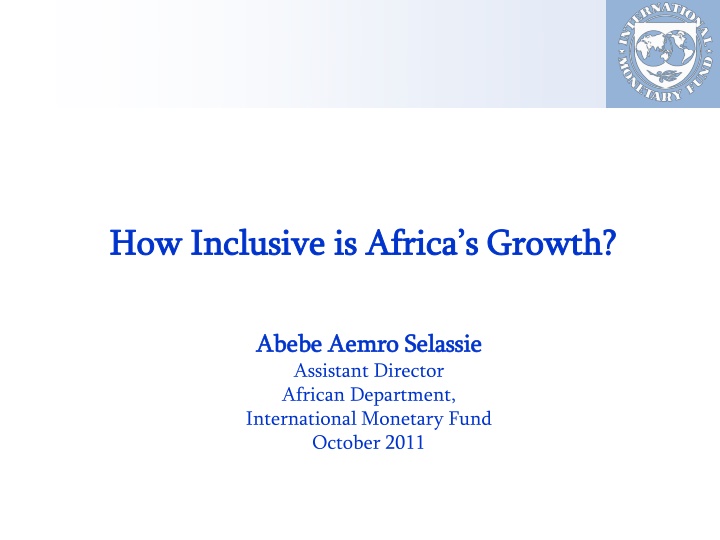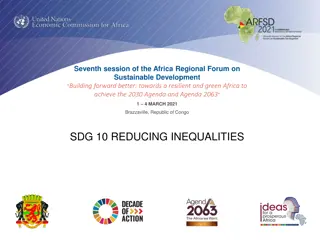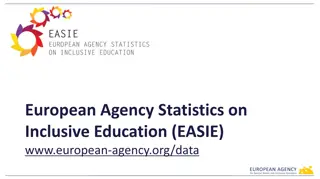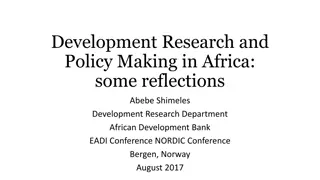How Inclusive is Africa’s Growth
Analyzing the inclusivity of Africa's economic growth, Abebe Aemro Selassie, IMF's Assistant Director for the African Department, sheds light on the challenges and opportunities. The discussion delves into the need for inclusive growth policies and strategies to ensure sustainable development and reduce inequality across the continent.
Download Presentation

Please find below an Image/Link to download the presentation.
The content on the website is provided AS IS for your information and personal use only. It may not be sold, licensed, or shared on other websites without obtaining consent from the author.If you encounter any issues during the download, it is possible that the publisher has removed the file from their server.
You are allowed to download the files provided on this website for personal or commercial use, subject to the condition that they are used lawfully. All files are the property of their respective owners.
The content on the website is provided AS IS for your information and personal use only. It may not be sold, licensed, or shared on other websites without obtaining consent from the author.
E N D
Presentation Transcript
How Inclusive is Africas Growth? How Inclusive is Africa s Growth? Abebe Aemro Selassie Abebe Aemro Selassie Assistant Director African Department, International Monetary Fund October 2011
Outline Apparent disconnect between growth and poverty outcomes but mainly on the basis of cross-country studies Case study approach has much to commend it Measuring real income Tentative conclusions International Monetary Fund, Regional Economic Outlook for sub-Saharan Africa, October 2011 2
Apparent disconnect between growth and poverty outcomes in sub-Saharan Africa (SSA) Real GDP and per Capita Growth, 1980-2010 Per Capita Growth and Poverty Reduction 6.0 15 Real GDP Real GDP per Capita 5.0 10 4.0 5 Average change in US$1.25 poverty headcount (percent) 0 3.0 Average in percent -5 2.0 y = -0.2768x - 2.4303 R = 0.0184 -10 1.0 -15 0.0 -20 -25 -1.0 -3 -2 -1 0 1 2 3 4 Average per capita growth (percent) -2.0 1980 84 1985 89 1990 94 1995 99 2000 04 2005 10 International Monetary Fund, Regional Economic Outlook for sub-Saharan Africa, October 2011 3
When we consider only the countries that have sustained high growth over the 1995-2010 period, there is a somewhat stronger link between growth and poverty reduction Sub-Saharan Africa High Growth Countries 15 Average change in $1.25 poverty hdcount (%) NGA 10 5 TZA RWA RWA 0 BFA NGA MOZ ETH UGAUGA UGA MWI UGA GHA MLI TZA BFA MOZ GHA MLI -5 ETH y = -0.966x + 0.648 R = 0.2264 -10 UGA -15 -2 0 2 4 6 8 Average per capita growth (%) International Monetary Fund, Regional Economic Outlook for sub-Saharan Africa, October 2011 4
Accounting for the stylized facts Perhaps the most dominant view is that weak poverty reduction reflects: Insufficient growth (Fosu, 2010) Highly unequal initial income distribution Unpropitious patterns of growth (Teal, 2011) More recently, some authors have argued that the extent of poverty reduction in the region is being underestimated: Income vs. consumption (Sala-i-Martin and Pinkovsky, 2010) Changes in the ownership of assets paint a different picture about income growth (Young, 2010) International Monetary Fund, Regional Economic Outlook for sub-Saharan Africa, October 2011 5
Case studies on the inclusiveness of growth Country sample: Cameroon, Ghana, Mozambique, Tanzania, Uganda, and Zambia Absolute vs. Relative measures of inclusiveness Absolute: annual per capita increase in consumption of poorest quartile Relative: how did the poorest quartile fare relative to he richest quartile We also looked Determinants of consumption Employment outcomes International Monetary Fund, Regional Economic Outlook for sub-Saharan Africa, October 2011 6
Core results Absolute measure: The poorest quartile of the consumption distribution in 4 out of 6 countries experienced relatively high (3 percent) annual growth in consumption. These four countries are Ghana, Mozambique, Tanzania, and Uganda, and all of them are high-growth countries. In Cameroon: growth was low, and annual per capita consumption for the poorest quartile grew by just 1 percent. In Zambia, per capita consumption of the poorest quartile was negative. Relative concept: the poorest quartile did better than the highest quartile in Cameroon, Uganda. (In Zambia, too, but only in the sense that consumption decline was less negative than for the richest quartile.) International Monetary Fund, Regional Economic Outlook for sub-Saharan Africa, October 2011 7
Per Capita GDP Growth and Consumption Growth of the Poorest Quartile 6 5 4 3 2 Percent 1 0 -1 -2 GDP Growth per Capita Per Capita Consumption Growth of the Poorest quartile -3 Per Capita Consumption Growth of the Poorest quartile (using regional price deflators) -4 Cameroon Zambia Ghana Tanzania Uganda Mozambique International Monetary Fund, Regional Economic Outlook for sub-Saharan Africa, October 2011 8
Growth rate of real consumption per capita by percentile of the distribution: the low-growth cases Cameroon 2001-2007 Zambia 19982004 4 1 3 Annual growth rate (percent) Annual growth rate (percent) -1 2 1 -3 0 -5 -1 -7 -2 -9 -3 1 10 20 30 40 50 60 70 80 90 100 Consumption percentiles 1 10 20 30 40 50 60 70 80 90 100 Consumption percentiles Growth incidence Growth in mean 95 percent confidence bounds Mean growth rate International Monetary Fund, Regional Economic Outlook for sub-Saharan Africa, October 2011 9
Growth rate of real consumption per capita by percentile of the distribution: the high-growth cases 6 Annual growth rate (percent) 8 Ghana, 1998-2005 Uganda, 2003-2010 Annual growth rate (percent) 5 4 6 3 4 2 1 2 0 -1 0 1 10 20 30 40 50 60 70 80 90 100 Consumption percentiles 1 10 20 30 40 50 60 70 80 90 100 Consumption percentiles Annual growth rate (percent) 7 Tanzania, 2001-2007 Mozambique, 2002-2008 Annual growth rate (percent)9 6 5 3 3 0 1 -3 -1 1 10 20 30 40 50 60 70 80 90 100 Consumption percentiles 1 10 20 30 40 50 60 70 80 90 100 Consumption percentiles 95 percent confidence bounds Mean growth rate Growth incidence Growth in mean International Monetary Fund, Regional Economic Outlook for sub-Saharan Africa, October 2011 10
A close relationship exists between GDP growth per capita and consumption growth of the poorest quartile Macroeconomic, Poverty, and Consumption Aggregates in Sample Countries (Annual percentage change, except where stated) Growth per Capita Poverty Headcount Period Gini Coefficient Per Capita Consumption NIPA data Survey data All Poorest quartile Ratio of poorest quartile to average Latest estimate Initial estimate Latest estimate households Cameroon 2001 07 0.57 9.6 -3.9 0.4 0.39 1.0 0.82 1.0 1.24 Zambia 1998 2004 1.16 64.3 1.5 0.53 0.51 0.5 -3.43 -1.9 Ghana 1998 2005 2.33 30.0 -1.3 0.41 0.43 3.6 3.66 2.6 0.71 Tanzania 2000 07 4.38 67.9 -3.0 0.35 0.38 3.7 6.73 3.9 0.58 Uganda 2002 09 4.45 28.7 -4.1 0.46 0.44 3.6 3.40 4.7 1.37 3.50 2.9 0.82 Mozambique1 2003 09 5.54 60.0 -2.5 0.47 0.46 7.2 0.69 -1.3 Memo items: Bangladesh2 1992 2000 3.00 57.8 -1.1 0.28 0.33 0.8 1.80 1.0 0.56 Cambodia3 1994 2004 5.70 40.2 -0.8 0.35 0.42 5.8 2.80 0.80 0.29 Vietnam3 1993 2002 5.90 40.1 -2.6 0.34 0.38 4.2 5.50 4.0 0.73 1 For per capita consumption growth rates, upper line is deflated by aggregate CPI, lower line is deflated by regional CPIs 2 Estimate based on Bangladesh growth incidence curve. 3 For Cambodia and Vietnam, the poorest quintile replaces the poorest quartile. International Monetary Fund, Regional Economic Outlook for sub-Saharan Africa, October 2011 11
The variation in consumption can be explained by 4-5 variables and these determinants are broadly stable across time and similar across countries Log Household Consumption Determinants (Most Recent Survey)1 Ghana 2005 Cameroon 2007 Uganda 2009 Mozambique 2008/09 Tanzania 2007 Zambia 2004 Household size (log) 0.37 *** 0.29 *** 0.24 *** 0.26 *** 0.31 *** 0.17 *** Age (log) 0.13 *** 0.18 *** 0.20 *** 0.16 *** 0.02 0.05 *** Male head of household 0.03 *** 0.01 0.08 *** 0.04 *** 0.06 ** 0.02 Employment dummy 0.16 *** 0.04 ** 0.02 0.07 *** 0.21 *** 0.07 *** Agriculture sector dummy Manufacturing sector dummy2 Government sector dummy -0.23 *** -0.08 *** -0.12 *** -0.15 *** -0.03 ** 0.19 *** -0.09 *** -0.10 * 0.16 *** -0.12 *** -0.11 *** 0.02 -0.26 *** -0.04 *** 0.03 * 0.02 0.15 *** Primary schooling Lower secondary schooling Upper secondary schooling College/nursing/teacher training 0.07 ** 0.16 *** 0.38 *** 0.69 *** 0.08 *** 0.16 *** 0.29 *** 0.59 *** -0.14 *** -0.04 0.01 0.87 *** 0.12 *** 0.22 *** 0.56 *** 1.00 *** 0.13 *** 0.44 *** 0.71 *** 1.23 *** 0.04 * 0.13 *** 0.47 *** 1.03 *** Urban dummy 0.24 *** 0.21 *** 0.20 *** 0.12 *** 0.23 *** 0.12 *** Diagnostic statistics Number of observations 7280 10416 6117 9836 9332 17824 R -squared 0.68 0.69 0.63 0.66 0.66 0.59 Sources: IMF staff estimates based on data from various household surveys (see Appendix I). Note: ***,**,* indicate statistical significance at the 99 percent, 95 percent, and 90 percent levels, respectively. 1Characteristics refer to head of household except for household size and urban dummy. 2For Zambia, the manufacturing dummy refers to nonagriculture, nongovernment salaried employment. International Monetary Fund, Regional Economic Outlook for sub-Saharan Africa, October 2011 12
Employment growth has been strong and rural agricultural employment growth provides much of the explanation of per capita consumption growth among the poorest households Employment Indicators (Annual percentage change, except where stated) Employment Output Elasticity Formal Sector Employment1 Total Urban Employment Agricultural Employment Rural Agricultural Employment Period Employment Cameroon 2001 07 2.7 0.8 5.6 5.9 4.2 9.5 Ghana 1999 2005 3.4 0.7 6.1 3.5 1.4 13.3 Mozambique 2003 09 4.4 0.6 7.4 3.4 -0.4 16.7 Tanzania 2000 09 3.3 0.5 8.8 2.3 2.1 9.5 Uganda 2002 09 7.5 1.0 9.8 6.0 6.4 13.9 Zambia 1998 2004 1.9 0.6 5.1 -0.2 -1.6 13.8 Memo items: Cambodia Vietnam2 Sub-Saharan Africa (sample median) 2004 07 2000 07 4.2 2.9 0.4 0.4 4.5 6.1 3.9 -0.3 4.7 n.a. 25.0 44.0 3.3 0.6 6.8 3.5 1.8 13.6 Sources: Household surveys; Vietnam Ministry of Planning and Investment and UNDP (2010); World Bank (2008). 1Latest estimate in percent of working-age population. 2Agricultural employment is for 2000 08. International Monetary Fund, Regional Economic Outlook for sub-Saharan Africa, October 2011 13
Engels Law: the share of total consumption devoted to food decline as real total income increases. Support for this empirical regularity exists both across and within countries Food expenditure share and household consumption expenditure per capita in a sample of 84 countries (2010) Food expenditure as a share of total household consumption by deciles of the total household consumption distribution in Ghana Food share 1991 Food share 1998 Average 1991 Average 1998 50 45 Food share 2005 Average 2005 0.70 40 0.65 35 0.601 0.595 0.560 30 Percent 0.60 Percent 25 0.55 20 15 0.50 10 0.45 5 0 0.40 6 7 8 9 10 11 1 2 3 4 5 6 7 8 9 10 Total household consumption expenditures per capita in US dollars (Ln) Deciles of the total household consumption distribution International Monetary Fund, Regional Economic Outlook for sub-Saharan Africa, October 2011 14
Insights from Engles Curves Estimates Evidence of real income being underestimated in Cameroon, Ghana and Zambia In Uganda, evidence of income being overestimated Main reason for the bias in the measurement of income likely because CPI inflation is overstated International Monetary Fund, Regional Economic Outlook for sub-Saharan Africa, October 2011 15
Summary Cross country evidence of limited value in assessing the link between poverty and growth Growth is central for poverty reduction, but not sufficient. Strong linkages between agricultural growth and poverty reduction, policies to improve agricultural output and productivity likely to be useful Policies that promote broad and sustainable growth should continue, but temporary and well targeted transfer programs could be introduced to protect the poor Some evidence supporting those that argue that real income may be being underestimated International Monetary Fund, Regional Economic Outlook for sub-Saharan Africa, October 2011 16























